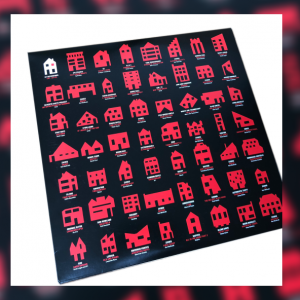Eamonn Doyle‘s D1 Recordings label has had a massive influence on electronic music in Ireland. When it was founded in the mid ’90s, there was virtually no local coverage of the vibrant underground music and club scene here, and certainly no official support for it – if you weren’t playing guitars, you just didn’t get taken seriously as a musician.
Against that backdrop, D1 Recordings gave a voice to dozens of local artists, spawned the Dublin Electronic Arts Festival, and in its heyday in the early ’00s pumped out classics from Donnacha Costello, Americhord and Bas Bron from its HQ in Moore Street.
So it’s understandable that Doyle and crew are making a big deal of the label’s 25th anniversary with this box set. It’s a huge collection: with nearly 5 hours of music stretching over 6 discs, it’s not so much a listening experience as a tour of duty. It bravely opts for all new tracks instead of rehashing old highlights, and though it includes label stalwarts like Rob Rowland, Scott Logan and Doyle himself (under 3 different aliases), it also features much more recent artists such as Joni and TrOne.
The advantage of this multi-generational approach is its diversity. D1 Recordings is best known for soulful techno, but the sounds here stretch from the downtempo analogue melancholia of Splitradix to Joni & Kaboogie‘s trip-hoppy Demons to some hard-funking electro from Americhord and Five Green Circle. Older names like Derek Carr trace Dublin’s continuing affinity for Detroit, and the always excellent Jonny Dillon contributes a characteristically tasty piece of melodic bleeps and beats.
However, as a coherent collection it’s frustrating: tempos ebb and flow massively over successive tracks, and the sequencing seems to aim more for disjunction than transition. D1 Recordings’ funky house segues into K1‘s mechanistic Berlin techno, and Shawn Rudiman‘s acid leads are bizarrely followed by the smooth shuffle of a track from Scott Logan’s Foot Note. It’s as though four different club nights booked the same venue at the same time, drew straws for turns on the decks, and then ended up fighting anyway over who was going next.
The result is that there seems to be both too little and too much of everything. There are plenty of harder cuts that are better suited to playing out than to home listening. But because they’re split over several sides, their momentum is constantly dissipated by the slower tracks that follow them. David Donahue ups the tempo to 140BPM on the driving A Thousand Leaves, and then Annie Hall takes it straight back down to 120 on Observer Effect.
And the opposite effect is at play for the downbeat tracks, especially the ambient pieces from Karl McGrath’s Zvuku project that close each side. When listened to together, they create an experience that’s at once contemplative and unsettling, dissolving pieces of sometimes familiar sounds into timbral clouds that are swathed in static, as though they’re the intercepted transmissions of a long-extinct alien civilisation. But when placed as they are here, at the end of sequences in entirely different styles, they become merely generic fadeouts.
The other curious thing about the collection is that almost all the names featured are male. This may be representative of D1’s roster – only Annie Hall and Americhord’s Maura Boyle have previously released on the label – but in the era of Sounding The Feminists and Gash Collective it seems unbalanced.
The inclusion of contemporary classical composers Irene and Linda Buckley may be an attempt to address this, but with just a single track from each, it feels tokenistic. It also feels like a missed opportunity: both work in a similar idiom to that of D1’s ambient artists, with an inventiveness that’s sometimes missing in the more upbeat tunes.
And that’s the final quibble: though this isn’t a retrospective, it can at times feel as though we’re partying like it’s 1999. Donnacha Costello’s PanoramaBa is a beautifully-modulated minimal jam, but it wouldn’t have sounded out of place on ‘Colorseries’ 15 years ago. And Glenn Davis’s soaring strings on Oh My Love are euphoric, but his use of ethnic music samples is less so. Really, in 2019 are we still using these as a shorthand for soul and authenticity?
These days Doyle is better known as a photographer, and in April the Royal Hibernian Academy ran a stunning exhibition of dozens of works from his last 3 photobooks. The sheer volume of pictures there showed how he makes powerful use of the immersive effect of multiples. So it’s strange that in this collection he’s chosen instead to split genres and tempos in a way that feels dilutive rather than additive.
There’s plenty here to celebrate D1’s Moore Street glory days, including some tracks that hold their own with anything being produced elsewhere in Europe. But in the end, it’s a little too redolent of Moore Street’s pile-it-high, sell-it-cheap brand of business.

